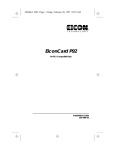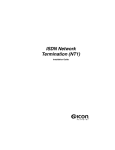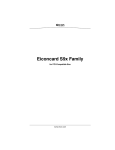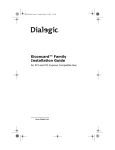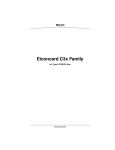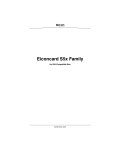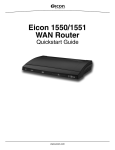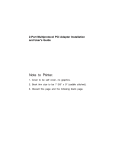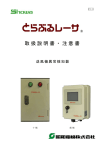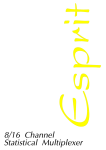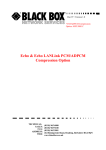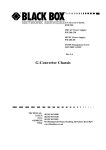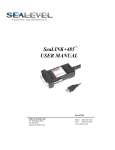Download Eicon Networks S90 Installation guide
Transcript
EiconCard S90 for PCI-Compatible Bus Installation Guide 203-187-01 First Edition (March 1998) Eicon, EiconCard, and EiconCard S90 are trademarks of Eicon Technology Corporation. Changes are periodically made to the information herein; these changes will be incorporated into new editions of the publication. Eicon Technology may make improvements and/or changes in the products and/or programs described in this publication at any time. A product comment form is provided at the back of this publication. If the form has been removed, address your comments to the attention of Corporate Publications at the address shown below, or by electronic mail to [email protected]. Eicon Technology may use or distribute whatever information you supply in any way it believes appropriate without incurring any obligations to you. Copyright © 1998 Eicon Technology Corporation. All rights reserved, including those to reproduce this publication or parts thereof in any form without permission in writing from Eicon Technology Corporation. Eicon Technology Corporation 9800 Cavendish Blvd. Montreal, Quebec Canada, H4M 2V9 Table of Contents Introduction............................................................................ 5 Installing the EiconCard S90 ................................................. 6 Selecting an Interface............................................................. 7 Interface Specifications.......................................................... 8 Cable Construction Information ............................................................ 9 The V.24 Interface ................................................................................ 10 The V.35 Interface ................................................................................ 12 The EIA-530 Interface ......................................................................... 14 The V.36/RS-449 Interface................................................................... 16 The X.21 Interface ............................................................................... 18 Back-to-Back Connections .................................................................. 20 Technical Specifications ...................................................... 21 International Regulatory Information .................................. 22 Limited Warranty................................................................. 25 Introduction The EiconCard S90 is a PCI Plug-and-Play (PnP) card that offers X.25 connectivity through a high-speed port (supporting V.24, V.35, EIA-530, V.36/RS-449, or X.21 interfaces) at speeds of up to 2 Mbps. Note The EiconCard S90 also supports protocols such as SDLC, PPP, and Frame Relay. Hardware Features The EiconCard S90 features a 25 MHz Motorola 68302 microprocessor with 1 MB of RAM and 1 MB of FLASH memory. It has one independent Very High-Speed Interface (VHSI) port, supporting full duplex communications over a V.24, V.35, EIA-530, V.36/RS-449, or X.21 interface at speeds of up to 2 Mbps (depending on the type of interface selected). Ease of Use The EiconCard S90 features automatic interface selection. The intelligent controller on the card detects the type of cable connected to the VHSI port and automatically selects the matching interface. About this Manual This guide describes how to install the EiconCard S90 in any computer with an IBM PC-compatible PCI bus. It covers the following topics: • Installing the card and connecting cables. • Interpreting the status light on the card. For instructions on setting up communications protocols and using applications, consult the documentation provided with your networking software. EiconCard S90 Installation Guide 5 Installing the EiconCard S90 The steps below describe how to install the EiconCard S90. If you want the EiconCard S90 to be available to multiple users on a LAN, install it in the PC that will function as a gateway for the LAN. 1 Prepare the PC Turn off the PC and disconnect its power cable. Remove the cover of the PC according to the instructions that came with it. 2 Install the EiconCard S90 Insert the EiconCard S90 into any available PCI port. Secure the EiconCard S90 to the chassis of the PC using the bracket-retaining screw. Reinstall the cover of the PC and reconnect the power cable. 3 Test the EiconCard S90 The application software that you purchased with the EiconCard S90 includes a test program to verify the card’s integrity. Consult the documentation supplied with this software for details. 4 Configure the EiconCard S90 Before you can use the EiconCard S90, you must configure it to work with your communications software. The documentation which came with this software contains complete instructions on how to configure the card. During configuration, note that the LED flashes. This feature is useful when more than one card is installed in the same PC. Consult the documentation which came with your networking software for more information about the LED. LED Port Figure 1. End Bracket 6 EiconCard S90 Installation Guide Selecting an Interface The EiconCard S90 can connect as a DTE to devices such as Data Service Units (DSUs) which support one of the following interfaces: V.24, V.35, EIA-530, V.36/RS-449, or X.21. It can also connect directly to a host computer, or back-to-back to another EiconCard. Table 1 lists the most common connections supported by the VHSI port, and specifies the part number of the required Eicon Technology cable. For information on making your own cables, see “Interface Specifications” on page 8. Interface Connection Part # V.24 to V.24 DCE 300-077 to V.24 DTE 300-078 V.35 to V.35 DCE 300-076 to V.35 DCE (France) 300-083 EIA-530 to EIA-530 DCE 300-080 V.36/RS-449 to V.36/RS-449 DCE 300-079 X.21 to X.21 DCE 300-081 Direct to VHSI port on another EiconCard S90 or compatible Eicon Technology EiconCard 300-075 Table 1. Standard Interface Cables To use an interface, simply install the appropriate cable. The EiconCard S90 recognizes the cable and automatically prepares the port for that interface. Consult the documentation which came with your networking software for more information about port configuration. EiconCard S90 Installation Guide 7 Interface Specifications The standards compliant with each interface supported on the VHSI port are listed in Table 2. The rest of this section describes the allocation of pins used to implement the electrical and signaling requirements of each interface. A wiring diagram is also provided, to show the correspondence of the interface pinout to the VHSI port. Interface Standard Compatibility V.24 CCITT V.24 Signaling CCITT V.28 Electrical CCITT X.21bis Electrical and signaling EIA RS-232-C Electrical and signaling ISO 2110 Connector type for the DCE side of a V.24 VHSI Modem Cable CCITT V.28 Some signals for electrical CCITT V.35 Some signals for electrical and signaling ISO 2593 Connector type for the DCE side of a V.35 VHSI Modem Cable RS-422 Electrical V.35 EIA-530 V.36/RS-449 X.21 RS-423 Electrical ISO 2110 Connector type for the DCE side of a EIA530 VHSI Modem Cable CCITT V.10 Electrical CCITT V.11 Electrical RS-422 Electrical RS-423 Electrical ISO 4902 Connector type for the DCE side of a V.36/ RS-449 VHSI Modem Cable CCITT X.21 Signaling CCITT V.11 Electrical CCITT X.27 Electrical EIA RS-422-A Electrical ISO 4903 Connector type for the DCE side of an X.21 VHSI Modem Cable Table 2. Interface Compatibility 8 EiconCard S90 Installation Guide Cable Construction Information If you plan to construct your own VHSI cables, be sure to observe the guidelines given below. Wire Gauge, Grounding, and Pairing • Use 28 AWG 7-strand wire with 0.020–0.028" insulation. • The chassis must be grounded both by a drain wire and by the braid; both must be connected to the connector case and shell at each end of the cable. The braid must be connected through its full circumference. • Wires identified under the heading “Twisted Pairs” must be paired. If you do not install twisted pairs correctly, the cable will not work. Type of Connectors The VHSI port accepts a high density 36-pin male cable connector. The types of connectors used on the interface-specific end of the cable are as follows: Interface Connector V.35 Type M V.24 DB25 V.36/RS-449 DB37 EIA-530 DB25 X.21 DB15 Table 3. Connector Types EiconCard S90 Installation Guide 9 The V.24 Interface A pin-out diagram for the V.24 interface is shown in Figure 2. The signal definitions and names are listed in Table 4. PG N D TXD RXD RTS CTS DSR SG N D DCD 1 14 TCLK RCLK TEST DTR RLB RI DTECLK TI 25 13 Figure 2. V.24 Interface Pin # 1 2 3 4 5 6 7 8 15 17 18 20 21 22 24 25 Signal PGND TXD RXD RTS CTS DSR SGND DCD TCLK RCLK TEST DTR RLB RI DTECLK TI Name Protective Ground Transmit Data Receive Data Request to Send Clear to Send Data Set Ready Signal Ground Data Carrier Detect Transmit Clock (DCE) Receive Clock Local Loopback Activation Data Terminal Ready Remote Loopback Ring Indicator Transmit Clock (DTE) Test Indicator Direction Common Output Input Output Input Input Common Input Input Input Output Output Output Input Output Input Table 4. V.24 Interface Signals 10 EiconCard S90 Installation Guide CCITT # 101 103 104 105 106 107 102 109 114 115 141 108 140 125 113 142 VHSI—V.24 Connections The wiring diagram below shows the connections required to construct a VHSI—V.24 cable. For the additional information required to construct your own cables, see “Cable Construction Information” on page 9. VHSI V.24 7 9 11 12 13 15 16 18 20 21 25 30 33 34 1 2 3 19 5 17 6 10 8 14 23 35 24 28 26 32 23 35 24 5 6 2 8 15 17 22 3 18 4 20 21 25 7 1 DRAIN WIRE BRAID Figure 3. VHSI—V.24 Connections EiconCard S90 Installation Guide 11 The V.35 Interface A pin-out diagram for the V.35 interface is shown in Figure 4. The signal definitions and names are listed in Table 5. SGND CTS DCD RI TEST RLB R XD + R XD R C LK + R C LK - B TI NN A P G ND RTS DSR DTR T X D+ TX DCLK+ CLKT CLK+ TCLK- MM Figure 4. V.35 Interface Pin # A B C D E F H J L N P R S T U V W X Y AA NN Signal Name Direction CCITT # PGND SGND RTS CTS DSR DCD DTR RI TEST RLB TXD+ RXD+ TXDRXDCLK+ RCLK+ CLKRCLKTCLK+ TCLKTI Protective Ground Signal Ground Request to Send Clear to Send Data Set Ready Data Carrier Detect Data Terminal Ready Ring Indicator Local Loopback Activation Remote Loopback Transmit Data Receive Data Transmit Data Receive Data Transmit Clock (DTE) Receive Clock (DCE) Transmit Clock (DTE) Receive Clock (DCE) Transmit Clock (DCE) Transmit Clock (DCE) Test Indicator Common Common Output Input Input Input Output Input Output Output Output Input Output Input Output Input Output Input Input Input Input 101 102 105 106 107 109 108 125 141 140 103A 104A 103B 104B 113A 115A 113B 115B 114A 114B 142 Table 5. V.35 Interface Signals 12 EiconCard S90 Installation Guide VHSI—V.35 Connections The wiring diagram below shows the connections required to construct a VHSI—V.35 cable. For the additional information required to construct your own cables, see “Cable Construction Information” on page 9. TWISTED PAIRS (MANDATORY) VHSI V.35 Y AA R T V X P S U W D E F J L C H N NN B A 5 23 6 24 8 26 10 28 14 32 9 11 13 18 21 25 30 33 34 36 1 3 19 DRAIN WIRE BRAID Figure 5. VHSI—V.35 DCEConnections EiconCard S90 Installation Guide 13 The EIA-530 Interface A pin-out diagram for the EIA-530 interface is shown in Figure 6. The signal definitions and names are listed in Table 6. PG ND TXD+ RXD+ RTS+ CTS+ DSR+ SG N D DCD+ RTXCDCDCL KTRXCCTS- 1 13 14 25 TXDTRXC+ RXDRTXC+ TEST RTSDTR+ RLB DSRDTRCLK+ TI Figure 6. EIA-530 Interface Pin # 1 2 3 4 5 6 7 8 9 10 11 12 13 14 15 16 17 18 19 20 21 22 23 24 25 Signal Name Direction CCITT # EIA # PGND TXD+ RXD+ RTS+ CTS+ DSR+ SGND DCD+ RTXCDCDCLKTRXCCTSTXDTRXC+ RXDRTXC+ TEST RTSDTR+ RLB DSRDTRCLK+ TI Protective Ground Transmit Data Receive Data Request to Send Clear to Send Data Set Ready Signal Ground Data Carrier Detect Receive Clock (DCE) Data Carrier Detect Transmit Clock (DTE) Transmit Clock (DCE) Clear to Send Transmit Data Transmit Clock (DCE) Receive Data Receive Clock (DCE) Local Loopback Request to Send Data Terminal Ready Remote Loopback Data Set Ready Data Terminal Ready Transmit Clock (DTE) Test Indicator Common Output Input Output Input Input Common Input Input Input Output Input Output Output Input Input Input Output Output Output Output Input Output Output Input 101 103A 104A 105A 106A 107A 102B 109A 115B 109B 113B 114B 106B 103B 114A 104B 115A 141A 105B 108A 140A 107B 108B 113A 142A BA(A) BB(A) CA(A) CB(A) CC(A) AB CF(A) DD(B) CF(B) DA(B) DB(B) CB(B) BA(B) DB(A) BB(B) DD(A) LL CA(B) CD(A) RL CC(B) CD(B) DA(A) TM Table 6. EIA-530 Interface Signals 14 EiconCard S90 Installation Guide VHSI—EIA-530 Connections The wiring diagram below shows the connections required to construct a VHSI—EIA-530 cable. For the additional information required to construct your own cables, see “Cable Construction Information” on page 9. TWISTED PAIRS (MANDATORY) VHSI EIA-530 4 22 5 23 6 24 7 25 8 26 9 27 11 29 12 30 13 31 17 35 21 33 34 1 2 19 2 14 15 12 3 16 4 19 17 9 5 13 6 22 20 23 8 10 24 11 18 21 25 7 1 DRAIN WIRE BRAID Figure 7. VHSI—EIA-530 Connections EiconCard S90 Installation Guide 15 The V.36/RS-449 Interface A pin-out diagram for the V.36/ RS-449 interfaces is shown in Figure 8. The signal definitions and names are listed in Table 7. 1 PG N D TXD+ TRXC+ RXD+ RTS+ RTXC+ CTS+ TEST DSR+ DTR+ DCD+ RLB RI CLK+ TI GND 20 TXDTRXCRXDRTSRTXCCTSDSRDTRDCD- C LK - 19 37 Fig. 8. V.36/RS-449 Interface Pin # Case 4 5 6 7 8 9 10 11 12 13 14 15 17 18 19 22 23 24 25 26 27 29 30 31 35 Signal Name Direction CCITT # PGND TXD+ TRXC+ RXD+ RTS+ RTXC+ CTS+ TEST DSR+ DTR+ DCD+ RLB RI CLK+ TI GND TXDTRXCRXDRTSRTXCCTSDSRDTRDCDCLK- Protective Ground Transmit Data Transmit Clock (DCE) Receive Data Request to Send Receive Clock (DCE) Clear to Send Local Loopback Activation Data Set Ready Data Terminal Ready Data Carrier Detect Remote Loopback Ring Indicator Transmit Clock (DTE) Test Indicator DTE Common Return Transmit Data Transmit Clock (DCE) Receive Data Request to Send Receive Clock (DCE) Clear to Send Data Set Ready Data Terminal Ready Data Carrier Detect Transmit Clock (DTE) Common Output Input Input Output Input Input Output Input Output Input Output Input Output Input Common Output Output Input Output Input Input Input Output Input Output 101 103A 114A 104A 105A 115A 106A 141A 107A 108A 109A 140A 125A 113A 142A 102A/B 103B 114B 104B 105B 115B 106B 107B 108B 109B 113B Table 7. V.36/RS-449 Interface Signals 16 EiconCard S90 Installation Guide VHSI—V.36/RS-449 Connections The wiring diagram below shows the connections required to construct a VHSI—V.36/RS-449 cable. For the additional information required to construct your own cables, see “Cable Construction Information” on page 9. TWISTED PAIRS (MANDATORY) VHSI V.36 / RS-449 4 22 5 23 6 24 7 25 8 26 9 27 11 29 12 30 13 31 17 35 18 21 33 34 1 2 19 4 22 5 23 6 24 7 25 8 26 9 27 11 29 12 30 13 31 17 35 15 10 14 18 19 20 37 DRAIN WIRE BRAID Figure 9. VHSI—V.36/RS-449 Connections EiconCard S90 Installation Guide 17 The X.21 Interface 1 A pin-out diagram for the X.21 interface is shown in Figure 10. The signal definitions and names are listed in Table 8. PG N D T(A) C(A) R(A) I(A) S(A) B(A) SGND 9 T(B) C(B) R(B) I(B) S(B) B(B) PG ND 8 15 Figure 10. X.21 Interface Pin # 1/15 2 3 4 5 6 7 8 9 10 11 12 13 14 Signal Name Direction CCITT # PGND T(A) C(A) R(A) I(A) S(A) B(A) SGND T(B) C(B) R(B) I(B) S(B) B(B) Protective Ground Transmit Data (+) Control Signal (+) Receive Data (+) Indication (+) Signal Element Timing (+) Byte Timing (+) Signal Ground Transmit Data (-) Control Signal (-) Receive Data (-) Indication (-) Signal Element Timing (-) Byte Timing (-) Common Output Output Input Input Input Input Common Output Output Input Input Input Input 101 103A 105A 104A 109A 115A 114A 102 103B 105B 104B 109B 115B 114B Table 8. X.21 Interface Signals 18 EiconCard S90 Installation Guide VHSI—X.21 Connections The wiring diagram below shows the connections required to construct a VHSI—X.21 cable. For the additional information required to construct your own cables, see “Cable Construction Information” on page 9. TWISTED PAIRS (MANDATORY) VHSI X.21 1 19 4 22 5 23 6 24 8 26 11 29 12 30 8 2 9 7 14 4 11 6 13 5 12 3 10 1 DRAIN WIRE BRAID Figure 11. VHSI—X.21 Connections EiconCard S90 Installation Guide 19 Back-to-Back Connections The wiring diagram below shows the connections required to construct a back-to-back VHSI—VHSI cable. Back-to-back operations are conducted through the V.36 interface. For the additional information required to construct your own cables, see “Cable Construction Information” on page 9. TWISTED PAIRS (MANDATORY) VHSI VHSI 6 24 4 22 4 22 6 24 5 8 26 23 7 9 27 25 11 29 12 30 17 35 13 31 12 30 11 29 7 9 27 25 5 8 26 23 13 31 17 35 1 2 19 1 2 19 DRAIN WIRE BRAID Figure 12. VHSI—VHSI Connections 20 EiconCard S90 Installation Guide Technical Specifications Technical Data • • • • PCI bus compatible (32-bit slot) Motorola 68302 CPU @ 25 MHz 1 MB RAM 1 MB FLASH memory Hardware Installation • Automatic configuration of interrupt request level setting and I/O address • 32-bit I/O access External Interface • One 36-pin female port VHSI Port • • • • One VHSI port connects to 36-pin high-density male connector Support for V.24, V.35, EIA-530, and V.36/RS-449 X.21 with V.11 (X.27) signaling Internal or external clocking (DTE or DCE) or split (transmit internal, receive external) Performance • 2 Mbps full duplex Power Requirements • 1.0 A @ +5V • 45 mA @ +12V • 50 mA @ -12V Environmental Requirements • • • • Operating temperature: 0°C to 50°C Operating humidity: 0 to 90% (non-condensing) Barometric operating pressure: 86 to 106 kPascals Maximum tolerance in power supply variation: +5% to -5% EiconCard S90 Installation Guide 21 International Regulatory Information Regulatory Information for the USA: FCC Warning Declaration of Conformity We: Eicon Technology Inc. 2155 Chenault Drive Suite 503 Carrollton, Texas USA 75006 1-800-80-EICON (972) 417-5515 Fax: (972) 417-5610 Declare under our sole legal responsibility that the product to which this declaration relates, are in conformity with Part 15 of the FCC Rules. Operation is subject to the following two conditions: (1) This device may not cause harmful interference, and (2) this device must accept any interference received, including interference that may cause undesired operation. Warning: Changes or modifications to this unit not expressly approved by Eicon Technology Corporation could void the user's authority to operate the equipment. Note: This equipment has been tested and found to comply with the limits for a Class B digital device, pursuant to Part 15 of the FCC Rules. These limits are designed to provide reasonable protection against harmful interference in a residential installation. This equipment generates, uses and can radiate radio frequency energy and, if not installed and used in accordance with the instructions, may cause harmful interference to radio communications. However, there is no guarantee that interference will not occur in a particular installation. If this equipment does cause harmful interference to radio or television reception, which can be determined by turning the equipment off and on, the user is encouraged to try to correct the interference by one or more of the following measures: • Reorient or relocate the receiving antenna. • Increase the separation between the equipment and receiver. • Connect the equipment into an outlet on a circuit different from that to which the receiver is connected. • Consult the dealer or an experienced radio/TV technician for help. • This device requires a shielded cable to comply with the FCC Class B emissions limits. Use of unshielded interface cables is prohibited. 22 EiconCard S90 Installation Guide Regulatory Information for Canada This digital apparatus does not exceed the Class B limits for radio noise emissions from digital apparatus set out in the Radio Interference Regulations of the Canadian Department of Communications. Le présent appareil numérique n’émet pas de bruits radioélectriques dépassant les limites applicables aux appareils numériques de la classe B prescrites dans le Règlement sur le brouillage radioélectrique édicté par le ministère des Communications du Canada. Regulatory Information for Europe This equipment displays the CE168 mark to show that it has been tested and found to fully comply with the Terminal Equipment, EMC and Low Voltage Directives (91/ 263/EEC, 89/336/EEC and 72/23/EEC, as amended by Directive 93/68/EEC). Safety Status: SELV No voltages within this equipment exceed SELV voltages. All interconnection points and ports are SELV. User/Installer Instructions for the United Kingdom EiconCard S90 Communications Board Important Safety Considerations When Installing Into A Host Computer System The EiconCard S90 is a half-length PCI compatible card. The EiconCard S90 is approved only for installation in an EN60950 approved host, surrounded by a minimum 2.5 mm air gap, and with host attachments which are either type approved for such apparatus, or, if supplied after March 1, 1989, are marked with or supplied with a statement that the host is supplied under: GENERAL APPROVAL NUMBER NS/G/1234/J/100003. Installation Within A Spare Slot Position In order to comply with Safety Regulations particular care should be taken to ensure adequate separation between the EiconCard S90, the components mounted on it, and any adjacent modules. Except at the edge connector which plugs into the host’s expansion slot, clearance and creepage distances of X mm and Y mm, as listed in Table 9, must be maintained between the EiconCard S90 card and other parts of the host including any other expansion cards fitted. Voltage used or generated by other parts of the host or expansion card Vrms or Vdc Clearance X mm Creepage Y mm 2.0 2.4 (3.8) up to 50 2.6 3.0 (4.8) up to 125 4.0 5.0 (8.0) up to 250 4.0 6.4 (10.0) up to 300 EiconCard S90 Installation Guide 23 Table 9. Creepage Distances The creepage distances apply when installed in a normal office environment. The creepage distances shown in parentheses apply where the local environment within the PC is subject to conductive pollution or dry non-conductive pollution which could become conductive due to condensation. These distances can be checked by measuring between the adjacent parts as shown below. X shows the clearance distance which is the shortest distance in air between two points. Y shows the creepage path (along surfaces) between the same two points. x y Figure 13. Typical Installation Power Consumption Check that power supply will not be overloaded. Maximum power consumption of the board is stated on page 21. The user should check that the total power drawn by the host computer, the EiconCard S90, and any other peripherals, does not exceed the capability of the host power supply unit. 24 EiconCard S90 Installation Guide Limited Warranty Eicon Technology Corporation warrants to the original purchaser of this Eicon Technology Product that it is to be in good working order for a period of five (5) years from the date of purchase from Eicon Technology or an authorized Eicon Technology dealer. Should this Product, in Eicon Technology’s opinion, fail to be in good working order at any time during this five year warranty period, Eicon Technology will, at its option, repair or replace this Product at no additional charge except as set forth below. Repair parts and replacement Products will be furnished on an exchange basis and will be either reconditioned or new. All replaced parts and Products become property of Eicon Technology. This Limited Warranty does not include service to repair damage to the Product resulting from accident, disaster, misuse, abuse, or non-authorized alterations, modifications, and/or repairs. Products requiring Limited Warranty service during the warranty period should be delivered to Eicon Technology with proof of purchase. If the delivery is by mail, you agree to insure the Product or assume the risk of loss or damage in transit. You also agree to prepay shipping charges to Eicon Technology and to use the original shipping container or equivalent. EICON TECHNOLOGY HEREBY DISCLAIMS ALL OTHER EXPRESSED AND IMPLIED WARRANTIES FOR THIS PRODUCT INCLUDING, BUT NOT LIMITED TO, THE WARRANTIES OF MERCHANTABILITY AND FITNESS FOR A PARTICULAR PURPOSE. Some jurisdictions do not allow the exclusion of implied warranties, so the above limitations may not apply to you. IN NO EVENT WILL EICON TECHNOLOGY BE LIABLE IN ANY WAY TO THE USER FOR DAMAGES, INCLUDING ANY LOST PROFITS, LOST SAVINGS, OR OTHER INCIDENTAL OR CONSEQUENTIAL DAMAGES ARISING OUT OF THE USE OF, OR INABILITY TO USE, SUCH PRODUCT. Some jurisdictions do not allow the exclusion or limitation of incidental or consequential damages for consumer products, so the above limitations or exclusions may not apply to you. THIS WARRANTY GIVES YOU SPECIFIC LEGAL RIGHTS, AND YOU MAY ALSO HAVE OTHER RIGHTS WHICH MAY VARY FROM ONE JURISDICTION TO ANOTHER. This Limited Warranty applies to hardware products only. EiconCard S90 Installation Guide 25 Product Comment Form EiconCard S90 Installation Guide 203-187-01 We value your comments. Please use the tables below to rate this product. Name Title Company Address EiconCard S90 Poor ➀ ➁ ➂ ➃ ➄ ➅ ➆ ➇ ➈ ➉ Excellent Difficult ➀ ➁ ➂ ➃ ➄ ➅ ➆ ➇ ➈ ➉ Easy Performance Poor ➀ ➁ ➂ ➃ ➄ ➅ ➆ ➇ ➈ ➉ Excellent Workmanship Poor ➀ ➁ ➂ ➃ ➄ ➅ ➆ ➇ ➈ ➉ Excellent Packaging Configuration Installation Guide Accuracy Organization Readability Presentation Low ➀ ➁ ➂ ➃ ➄ ➅ ➆ ➇ ➈ ➉ High Confusing ➀ ➁ ➂ ➃ ➄ ➅ ➆ ➇ ➈ ➉ Clear Difficult ➀ ➁ ➂ ➃ ➄ ➅ ➆ ➇ ➈ ➉ Easy Poor ➀ ➁ ➂ ➃ ➄ ➅ ➆ ➇ ➈ ➉ Excellent Please return this form to: Eicon Technology Corporation Attention: Corporate Publications 9800 Cavendish Blvd. Montreal, Quebec, Canada H4M 2V9 E-mail: [email protected] Fax: (514) 745-5588 Tel: (514) 745-5500 Printed in Canada




























